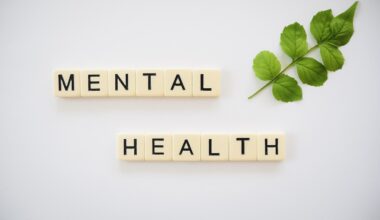The Influence of Growth Hormone on Muscle Growth and Recovery
Growth hormone (GH) plays a pivotal role in stimulating both muscle growth and recovery. Understanding how GH operates is crucial for athletes and fitness enthusiasts. This hormone is produced by the pituitary gland and impacts various bodily functions. One of its primary effects is on muscle tissues, where it promotes protein synthesis, leading to an increase in muscle mass. In addition to this anabolic effect, GH aids in the utilization of fat as an energy source. This process ensures that muscle glycogen is preserved during intensive workouts, enhancing performance efficiency. Elevated levels of GH can lead to improved body composition, as well. Moreover, GH contributes to the repair and regeneration of muscle after strenuous exercise. As muscles undergo micro-tears during workouts, growth hormone assists in recovering these tears and improving overall strength. It stimulates the production of insulin-like growth factor (IGF-1), further aiding in tissue repair. For individuals looking to maximize their training results, a focus on maintaining healthy GH levels can be a game changer. Therefore, understanding the implications of GH in fitness is essential for optimizing training recovery and muscle growth.
The Role of Growth Hormone in Body Composition
The role of growth hormone extends beyond just muscle repair; it significantly influences body composition. Research suggests that optimum GH levels can help reduce body fat while simultaneously promoting lean muscle gain. This dual effect is particularly beneficial for individuals looking to improve their physique or athletic performance. By increasing metabolic activity, GH aids in elevating the basal metabolic rate (BMR), thus encouraging the body to burn calories more efficiently. As a result, individuals might notice a decrease in stubborn fat deposits. Additionally, higher GH levels assist in the distribution of fat, further aiding in achieving a more toned appearance. Another vital aspect of GH is its role in maintaining organ health and decreasing the risk of certain diseases associated with obesity. Therefore, it’s essential to develop lifestyle habits that support healthy growth hormone production. Incorporating a balanced diet rich in nutrients, regular high-intensity training, and adequate sleep contributes to maintaining effective GH levels. This collective approach not only impacts muscle growth and recovery but also fosters healthy body composition’s overall enhancement.
Understanding the connection between sleep and growth hormone is equally important for optimal fitness results. The majority of GH secretion occurs during deep, restorative sleep phases. This crucial period underscores why sleep should never be underestimated by fitness enthusiasts. During these stages, the body undergoes essential repair and recovery processes, highlighting the relationship between sufficient rest and muscle growth. Lack of quality sleep may lead to decreased GH levels, impairing muscle recovery and overall athletic performance. Studies indicate that individuals lacking in sleep may face increased body fat and reduced muscle mass. To combat this challenge, establishing a consistent sleep routine is vital. Staying disciplined about bedtime and ensuring an adequate sleep environment can significantly enhance GH secretion. Also, nutrition plays a role in sleep quality; foods rich in magnesium, such as leafy greens and nuts, can help promote better rest. Ultimately, prioritizing both training and recovery, including sleep quality, is a fundamental approach to maximizing fitness goals. Embracing this holistic strategy, integrating growth hormone optimization through sleep, nutrition, and training is key to achieving peak performance.
Exercise and Growth Hormone Secretion
Various forms of exercise can significantly influence growth hormone secretion. High-intensity interval training (HIIT) and resistance training have been shown to elevate GH levels more effectively than moderate-intensity workouts. Engaging in short bursts of vigorous exercise not only promotes cardiovascular fitness but also stimulates the pituitary gland to release GH. The hormonal response can vary depending on the type, intensity, and duration of the exercise. Interestingly, longer workouts and increased muscle mass recruited during training can generate greater GH responses. Furthermore, incorporating compound movements like squats and deadlifts can lead to enhanced GH secretion. It’s important to note that recovery time matters; excessive training without proper rest can lead to diminished GH levels over time, thus impacting muscle growth. Recovery should focus on distance between high-intensity sessions, promoting effective rejuvenation of muscle fibers. Therefore, a suitable training regimen should include careful planning of workout intensity and duration. By strategically integrating HIIT and resistance training followed by quality recovery, individuals can optimize growth hormone secretion and subsequently achieve desired fitness goals.
Nutrition also plays a critical role in enhancing growth hormone levels. Specific dietary strategies can maximize GH secretion, especially surrounding workouts. Consuming protein-rich meals before and after training can drive GH release while providing essential amino acids for muscle repair. Low-glycemic index carbohydrates are another excellent addition to the diet, as they provide sustained energy without causing unwanted insulin spikes. These spikes can inhibit GH production and affect overall hormone balance. Including healthy fats, like omega-3 fatty acids, may further support the hormonal environment necessary for optimal GH levels. Foods such as fish, nuts, and seeds can promote this balance. Furthermore, staying hydrated is crucial, as dehydration can hinder hormone production, including GH. A proper hydration plan, combined with adequate nutrition before and after workouts, sets the stage for successful growth hormone optimization. Hence, ensuring your nutrition supports your training will not only aid in immediate performance but also enhances long-term muscle growth and recovery. A well-rounded approach to diet and hydration can amplify the overall impact of exercise on muscle development.
Age and Growth Hormone Levels
Age significantly impacts growth hormone levels and their related effects on muscle growth and recovery. As individuals grow older, the natural production of growth hormone tends to decline, which may lead to challenges in maintaining muscle mass and body composition. This decline can result in increased body fat and decreased muscle strength, factors that are detrimental to athletic performance. Understanding this age-related aspect can help individuals tailor their fitness efforts accordingly. While some may seek external GH treatments, it’s critical to consider healthier lifestyle modifications to optimize natural GH levels. Engaging in routine strength training and maintaining optimal body composition are effective strategies. Additional factors, like stress reduction through mindfulness techniques and consistent physical activity, can also assist in balancing hormone levels. Adequate sleep, as previously discussed, remains a non-negotiable cornerstone for healthy GH production, especially as we age. Moreover, regular check-ups with healthcare professionals can provide guidance on maintaining hormonal health. In this way, older adults can learn to adapt their training and lifestyle to obtain optimal levels of growth hormone for sustained muscle health.
The influence of growth hormone on muscle growth and recovery cannot be overstated. With the proper understanding of its role and factors affecting its production, individuals can strategize their fitness routines effectively. Emphasizing high-intensity training, adequate nutrition, and restorative sleep forms a comprehensive foundation for optimizing hormonal health. Furthermore, maintaining healthy lifestyle choices can significantly contribute to achieving optimal GH levels. Those striving for peak athletic performance should prioritize not just training intensity but also overall hormonal balance. Recognizing age-related changes in growth hormone production will empower individuals to make informed decisions about their physical activities. Through tailored exercise, supportive nutrition, and mindful living, people can maximize their muscle growth potential and enhance recovery times. Ultimately, investing in hormonal health is pivotal for physical wellness and long-term fitness success. As research continues to illuminate the relationships between growth hormone, exercise, nutrition, and recovery, we can adapt our fitness strategies for improved outcomes. Fitness enthusiasts must embrace a holistic view of health, integrating physical training with hormonal understanding to achieve their fitness aspirations.
Conclusion
In conclusion, to fully realize the benefits of growth hormone for muscle growth and recovery, understanding its implications encourages a proactive approach. Many factors play into optimizing GH, including lifestyle choices, types of exercise, dietary considerations, and psychological well-being. Embracing strength training and high-intensity workouts can stimulate natural GH production. Moreover, supportive nutrition and proper hydration are essential aspects of fitness that should not be overlooked. Quality sleep reaffirms its critical role by enhancing hormonal health, while age-related issues remind us to adapt our regimes accordingly. Integrating these elements can multiply the positive effects of growth hormone within training regimens. For those who wish to delve deeper, consulting healthcare specialists knowledgeable about hormonal health can provide additional personalized insights. This collective effort leads to improved muscle health, better recovery times, and enhanced athletic performance. Just as growth hormone nurtures muscles post-workout, fostering an overall understanding encourages better fitness outcomes. Therefore, the journey towards optimal hormonal health should be a priority for anyone committed to training, recovery, and overall well-being in their fitness pursuits.


